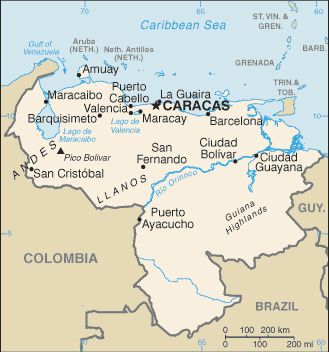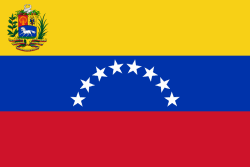Venezuela
Related Categories:
 Venezuela - Fotw
Venezuela - FotwNational and military flags, Coat of Arms.
www.fotw.us/
The flag is the one primarily adopted by the National Congress of 1811, consisting of three equal horizontal stripes... The yellow band stands for the wealth of the land, the blue for the waters separating Venezuela from Spain, and the red for the blood spilled by patriots during the independence struggle.
en.wikipedia.org/
People
Venezuela is the sixth-most populous country in Latin America, after Brazil, Mexico, Colombia, Argentina and Peru. About 85% of the population lives in urban areas in the northern portion of the country. While almost half of Venezuela's land area lies south of the Orinoco River in the states of Bolivar and Amazonas, this region contains only 5% of the population. The population of Venezuela is comprised of a combination of European, indigenous, and African heritages.
History
At the time of Spanish discovery, the indigenous in Venezuela were mainly agriculturists and hunters living in groups along the coast, the Andean mountain range, and the Orinoco River. The first permanent Spanish settlement in South America--Nuevo Toledo--was established in Venezuela in 1522. Venezuela was a relatively neglected colony in the 1500s and 1600s as the Spaniards focused on extracting gold and silver from other areas of the Americas.
Toward the end of the 18th century, the Venezuelans began to grow restive under colonial control. In 1821, after several unsuccessful uprisings, the country succeeded in achieving independence from Spain, under the leadership of its most famous son, Simon Bolivar. Venezuela, along with what are now Colombia, Panama, and Ecuador, was part of the Republic of Gran Colombia until 1830, when Venezuela separated and became a separate sovereign country.
Much of Venezuela's 19th-century history was characterized by periods of political instability, dictatorial rule, and revolutionary turbulence. The first half of the 20th century was marked by periods of authoritarianism--including dictatorships from 1908-35 and from 1950-58. In addition, the Venezuelan economy shifted after the first World War from a primarily agricultural orientation to an economy centered on petroleum production and export.
Since the overthrow of Gen. Marcos Perez Jimenez in 1958 and the military's withdrawal from direct involvement in national politics, Venezuela has enjoyed an unbroken tradition of civilian democratic rule. This earned Venezuela a reputation as one of the more stable democracies in Latin America. Until the 1998 elections, the Democratic Action (AD) and the Christian Democratic (COPEI) parties dominated the political environment at both the state and federal level.
www.state.gov/r/
Introduction
About
Contact
Symbols in The News
Interpret this Symbol
AAC
African
AI
Alchemy
Alphabets
Ancient
Animal Symbolism
Architecture
Art
Articles
Astrology
Baha'i
Blissymbolics
Blueprint Symbols
Buddhist
Celtic Symbols
Cemetery
Chinese Symbols
Christian
Circle
City
Codes
Color
Conlangs
Crop Circles
Danger
Da Vinci Code
Designing Logos
Dictionaries
Dreams
Education
Egyptian Symbols
Electrical
Emoticons
Find Images
Fonts
Food
Fraternity
Hamsa
Healing
Heraldry
Hermetic
Highway Signs
Hindu
History
Hobo
Holiday
Icons
iConji
Islamic
Jain Symbols
Japanese, Kanji
Jewish
Justice
Law
Literary Symbolism
Mandalas
Map
Masonic
Math, Number
Meaning of Names
Medical
Middle East
Military
Miscellaneous
Money
Music
Mythology
Native American
Playing Cards
Power
Psychology
QiQiiKhu
Reiki
Religious
Runes, Norse
Sacred Geometry
Scientific
Science Fiction
Sorority
Sports
Symbols in the News
Tattoos
ThirteenSymbols
Tree of Life
Ursprache
Videos
Visual Languages
Weather
Web Codes
Wicca
Words
Writing Systems
Braille
Coinherence
Coptic
Cuneiform
Easter Island
Etruscan
Happy Human
Hebrew
Kokopelli
Linear B
Lotus
Love Symbols
Mandorla
Moon Alphabet
Nine Pointed Star
Om
Oz
Phonetic
Scarab Beetle
Silent
Theosophy
Unifon
About
Contact
Symbols in The News
Interpret this Symbol
AAC
African
AI
Alchemy
Alphabets
Ancient
Animal Symbolism
Architecture
Art
Articles
Astrology
Baha'i
Blissymbolics
Blueprint Symbols
Buddhist
Celtic Symbols
Cemetery
Chinese Symbols
Christian
Circle
City
Codes
Color
Conlangs
Crop Circles
Danger
Da Vinci Code
Designing Logos
Dictionaries
Dreams
Education
Egyptian Symbols
Electrical
Emoticons
Find Images
Fonts
Food
Fraternity
Hamsa
Healing
Heraldry
Hermetic
Highway Signs
Hindu
History
Hobo
Holiday
Icons
iConji
Islamic
Jain Symbols
Japanese, Kanji
Jewish
Justice
Law
Literary Symbolism
Mandalas
Map
Masonic
Math, Number
Meaning of Names
Medical
Middle East
Military
Miscellaneous
Money
Music
Mythology
Native American
Playing Cards
Power
Psychology
QiQiiKhu
Reiki
Religious
Runes, Norse
Sacred Geometry
Scientific
Science Fiction
Sorority
Sports
Symbols in the News
Tattoos
ThirteenSymbols
Tree of Life
Ursprache
Videos
Visual Languages
Weather
Web Codes
Wicca
Words
Writing Systems
Braille
Coinherence
Coptic
Cuneiform
Easter Island
Etruscan
Happy Human
Hebrew
Kokopelli
Linear B
Lotus
Love Symbols
Mandorla
Moon Alphabet
Nine Pointed Star
Om
Oz
Phonetic
Scarab Beetle
Silent
Theosophy
Unifon

